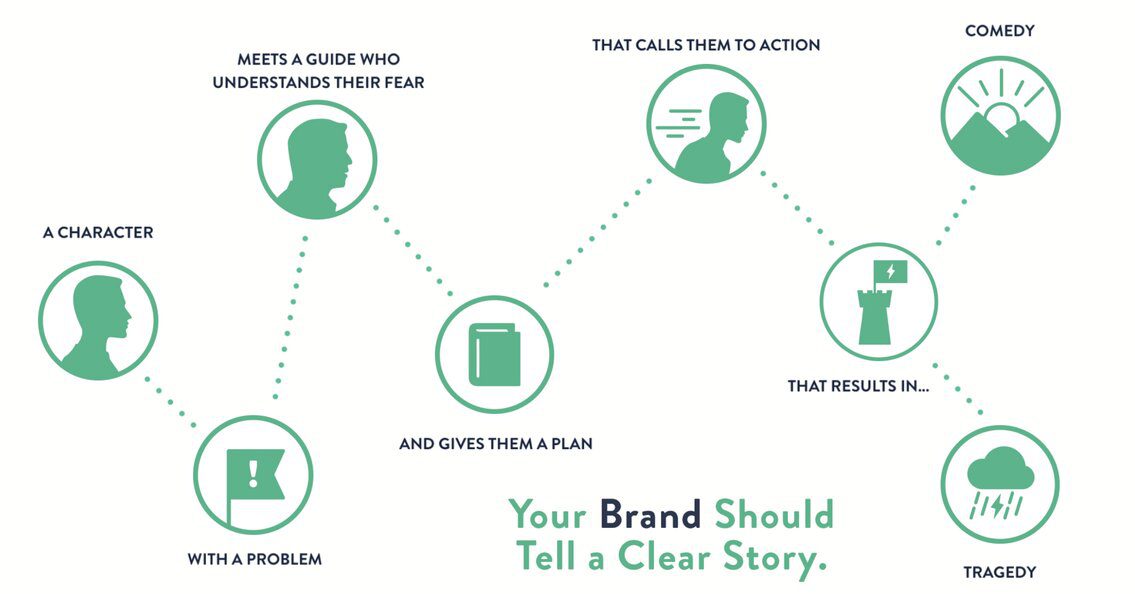The StoryBrand framework is a seven-part storytelling framework popularised by American author and public speaker Donald Miller, in his 2017 book, Building a StoryBrand: Clarify Your Message So Customers Will Listen. The SB7 Framework is a seven-step formula designed to help businesses streamline their marketing strategy by clarifying their message.
With the StoryBrand (SB7) Framework, you have the power to eliminate confusion, connect with customers, and grow your business.
The StoryBrand 7 Part Framework is based on the hero’s journey, which can be seen in most stories:
- Every story starts with a character who wants something.
- A problem gets in the way of the character getting what they want.
- The character encounters a guide who can help them overcome their problem and get what they want.
- The guide gives the character a plan
- Calls them to action.
- By taking that action, the character avoids failure and
- Helps them achieve success

Donald Miller’s StoryBrand 7-Part Framework in a nutshell:
- A Character
A major paradigm shift in the SB7 Framework is that the customer is the hero of the story, not your brand. When we position our customer as the hero and ourselves as the guide, we will be recognized as a trusted resource to help them overcome their challenges.
As a brand it’s important to define something your customer wants, because as soon as we define something our customer wants, we posit a story question in the mind of the customer: Can this brand really help me get what I want?
- Has a Problem
Once we identify who our customer is, we have to ask ourselves what they want as it relates to our brand. The catalyst for any story is that the hero wants something. The rest of the story is a journey about discovering whether the hero will get what they want.
The problem is the “hook” of a story, and if we don’t identify our customers’ problems, the story we are telling will fall flat. As soon as the conflict in a story is resolved, audiences stop paying attention.
- Meets a Guide
When a brand comes along and positions itself as the hero, customers remain distant. They hear us talking about how great our business is and start wondering if we’re competing with them for scarce resources. Their subconscious thought pattern goes like this: Oh, this is another hero, like me. I wish I had more time to hear their story, but right now I’m busy looking for a guide.
Always position your customer as the hero and your brand as the guide. Always. If you don’t, you will die. When we empathize with our customers’ dilemma, we create a bond of trust. People trust those who understand them, and they trust brands that understand them too.
- Who Gives Them a Plan
In almost every story, the guide gives the hero a plan, or a bit of information, or a few steps they can use to get the job done. People are looking for a philosophy they can embody or a series of steps they can take to solve their problems.
Plans can take many shapes and forms, but all effective plans do one of two things: they either clarify how somebody can do business with us, or they remove the sense of risk somebody might have if they’re considering investing in our products or services.
- Calls Them to Action
In stories, characters don’t take action on their own. They must be challenged. If we’re telling a story about a man who needs to lose thirty pounds and suddenly decides to do it of his own volition, the audience will check out. Why? Because that’s not how life works. There needs to be a reason.
Your customers are bombarded with more than three thousand commercial messages per day, and unless we are bold in our calls to action, we will be ignored. If our calls to action are soft, they will not be noticed.
- Helps Them Avoid Failure
Brands that help customers avoid some kind of negativity in life (and let their customers know what that negativity is) engage customers for the same reason good stories captivate an audience: they define what’s at stake.
The only two motivations a hero has in a story are to escape something bad or experience something good. Such is life. Our desire to avoid pain motivates us to seek a resolution to our problems.
- Ends in a Success
We must tell our customers how great their life can look if they buy our products and services. Everybody wants to be taken somewhere. If we don’t tell people where we’re taking them, they’ll engage another brand.
Nobody gets excited about a muddled vision. Stories aren’t vague, they’re defined; they’re about specific things happening to specific people. Otherwise, they’re not stories; they’re just lofty notions.
The StoryBrand Brandscript
The StoryBrand Brandscript is a free digital application that helps you build and clarify your message using the seven-part framework.
The Brandscript Website: https://www.mystorybrand.com/
